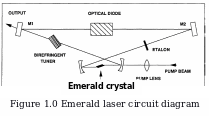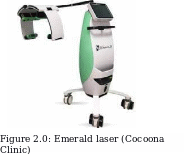Introduction
Tunable lasers allow the alteration of their wavelength in a controlled manner. The lasers exist in three states of matter: solid, gas, and liquid. Solid-state lasers use a solid gain medium, unlike dye lasers that utilise liquid. Emerald Laser is a solid-state laser that has an active medium consisting of a glass or crystalline host material, to which a dopant is added. While all solid-state lasers have common characteristics, their composition, tuning range, operation temperature, and pump are different. This paper discusses the properties, application, and price of the emerald laser.
General Description

The emerald laser is a solid-state tunable laser that emulsifies fat in the tissue under the skin. The laser’s principle of operation is to act on excess fat in the human body using colder laser technology to emulsify fat fabrics (Atanasov et al.). The laser’s wavelength can be altered since it is tunable. The emerald lasers are achieved running by pumping a Krypton continuous wave laser (Kr+) (Sennaroglu and Morova). However, with the improvements in the quality of the emerald crystals, from gem to optical quality, a high-power laser diode is significant. The laser utilises a basic plano-concave cavity as shown in figure 1.0.
Parameters of the Laser

The emerald laser has several parameters for effective functionality. Although the laser’s wavelength is tuneable, it operates the best at a wavelength of 532 nanometres. The wavelength and the light beam power determine the laser’s penetration beneath the skin surface and affect the type of body tissue. The device’s technical characteristics include the presence of 10 laser diodes which are placed over the patient’s problem areas. The laser can produce a radiation power of up to 22milliwatts with half-width of 20 nanometers (Atanasov et al.). The laser effect takes 20 to 30 minutes depending on the expert opinion. Emerald laser produces radiation energy that is 23% more than a conventional red laser beam.
Application
The primary role of the emerald laser is in low-level laser therapy (LLT). Laser technology is used to remove fats from the human body, non-invasively (Jin et al. 1155). The emerald laser is designed in such a manner that overlapping beams rotate for the laser energy to penetrate the skin. Consequently, the energy activates the intracellular enzyme cytochrome C oxidase. The enzyme creates tiny openings for fatty acids and glycerol to move out (Cocoona Clinic). LLT is better than surgery since it is painless and safe. Therefore, the use of LLT is not associated with the risks of infection.
Price
The price of an emerald laser is variable, depending on the country of purchase. The devices come in different designs, and at different prices. In the U.S., the handheld device costs about $7, 900. Meanwhile, the whole-body emerald laser machine costs about $40, 000. The price can shift to an excess of about 20% depending on the country of operation due to importation costs. The laser’s treatment services also vary: in the UK a treatment cycle can cost up to £245 and in the U.S. $400. The laser machine and its treatment costs are more expensive than surgical operations due to its safety and effectiveness.
Conclusion
Tunable lasers produce light beams at varying wavelengths. The lasers come in various states including solid, gas, and liquid. Emerald is a tuneable solid-state laser that is primarily used in LLT. The laser produces more radiation energy than the red laser beams. Unlike the surgical removal of fats from the body, the use of an emerald laser is non-invasive. However, the laser is expensive owing to its effectiveness in removing excess fats from the body.
Works Cited
Atanasov, Mihail, et al. “First-Principles Study of Optical Absorption Energies, Ligand Field and Spin-Hamiltonian Parameters of Cr3+ Ions in Emeralds.” Inorganic Chemistry, vol. 61, no. 1, 2021, pp. 178–92.
Cocoona Clinic. “Emerald Laser | Fat Reduction.” Web.
Jin, Yongyong, et al. “Non-Invasive Monitoring of Human Health by Photoacoustic Spectroscopy.”Sensors, vol. 22, no. 3, 2022, p. 1155, Web.
Sennaroglu, Alphan, and Yagiz Morova. “Divalent (Cr2+), Trivalent (Cr3+), and Tetravalent (Cr4+) Chromium Ion-Doped Tunable Solid-State Lasers Operating in the near and Mid-Infrared Spectral Regions.”Applied Physics B, vol. 128, no. 1, 2021, Web.